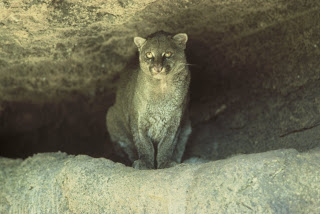by Scott Nicol
The long, low body moves in a
permanent crouch as the lithe cat glides through the shaded underbrush. Not much larger than a house cat, but with a
lean, dark body more closely resembling a weasel’s than a tabby’s, the
jaguarundi stalks small prey, birds and rodents mostly, in the thornscrub where
the Gulf Coast meets the Rio Grande.
Even before farms, towns, and
homes devoured 95% of the Lower Rio Grande Valley’s native habitat the jaguarundi’s
secretive habits meant it was rarely seen.
Now there is scant evidence as to how many cats remain, though they are
occasionally spotted. In 2009 there were two sightings by Texas
Parks and Wildlife game wardens, though they were officially classified as
unconfirmed in the absence of a photograph or carcass.
Loss of habitat and the
fragmentation of what forested areas remain is the biggest obstacle to
jaguarundi maintaining a healthy population, according to a draft recovery plan
recently prepared by the U.S. Fish and Wildlife Service. If a patch of forest is too small, it may not
contain enough food, and if patches are too far apart or split by roads or
other barriers jaguarundi may not have sufficient territory to survive. Isolated animals may also be cut off from
potential mates, which can lead to inbreeding within a small population.
Ocelots, a slightly larger wild
cat whose markings resemble a jaguar’s, inhabit the same South Texas territory
and face the same problems as the jaguarundi.
Ocelots are better studied, with radio collared individuals in Laguna
Atascosa National Wildlife Refuge. They
regularly pause in front of motion-activated cameras there and in the nearby
Lower Rio Grande Valley National Wildlife Refuge. Their total population in the United States
is certainly less than 100, and possibly much lower. Even fewer jaguarundi remain, which has led
to both being listed under the Endangered Species Act.
The best way to save both
species, according to U.S. Fish and Wildlife, is to provide them with enough
habitat to forage and find mates. The
draft recovery plan calls for the purchase of land to replace and reconnect the
native forest that they need, creating the wildlife corridor that the
river-hugging refuge was originally meant to be. But with the never-ending “fiscal cliff”
crisis and calls to butcher the budgets of federal agencies like U.S. Fish and
Wildlife they will be hard pressed to find the necessary funds.
When border walls were erected in
South Texas, they repeatedly sliced through the Lower Rio Grande Valley
National Wildlife refuge, fragmenting habitat that had been purchased
specifically for ocelots and jaguarundi.
Humans have had no problem climbing border walls, with or without a
homemade ladder, but for a small cat that has not evolved thumbs an 18 foot high
steel wall is insurmountable.
In 2008, after the Department of
Homeland Security waived the Endangered Species Act and more than thirty other
laws so that Customs and Border Protection could build border walls they
prepared a so-called “Environmental Stewardship Plan” meant, they said, to
demonstrate their continued commitment to the environment. To address the fragmentation of the Lower Rio
Grande National Wildlife Refuge and the loss of endangered species habitat the plan
stated that Customs and Border Protection would provide U.S. Fish and Wildlife
with the means to purchase 4,600 acres of land to reconnect sections of the
refuge that were separated by walls.
These properties would be purchased from willing sellers, because the
South Texas refuge complex refuses to condemn land and earn the enmity of its
neighbors, in contrast to Customs and Border Protection, who ultimately carried
out more than 400 condemnations to build border walls.
In the nearly five years since
Customs and Border Protection made that promise how much have they
delivered?
None.
Not one acre, not one foot, not
one inch.
It is not as though Customs and
Border Protection is strapped for cash.
A report issued this month found that the federal government throws more
money at immigration enforcement than it provides to the FBI, Secret Service,
Drug Enforcement Administration, U.S. Marshal Service, and the Bureau of
Alcohol, Tobacco, Firearms, and Explosives combined. Somewhere in the $18 billion pot of cash that
immigration enforcement agencies, Customs and Border Protection prominent among
them, were swimming in in 2012 surely they could find a few dollars to buy a
few acres and fulfill their overdue commitment.
Now Customs and Border Protection
wants to build more miles of border wall in South Texas, tearing through Roma,
Rio Grande City and Los Ebanos as well as further stretches of the Lower Rio
Grande Valley National Wildlife Refuge.
In addition to the further fragmentation of ocelot and jaguarundi
habitat that this would bring, these walls would stand in the Rio Grande
floodplain, putting communities on both sides of the river at risk from dammed
or deflected water during a major flood.
Last summer they assured
landowners and mayors that the new border walls would not pose a flood hazard, and
that despite the obvious fact that a wall in a river is by definition a dam
these walls would be just fine.
But as their unmet commitment to
be good environmental stewards has shown, a Customs and Border Protection
promise is not worth the paper it is written on.





No comments:
Post a Comment